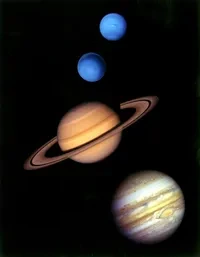
목성이나 토성과 같이 질량의 대부분을 유체가 차지하는 행성을 분류하는 형식으로, 특히 목성과 토성처럼 주요 구성성분이 수소, 헬륨 같은 가스 성분일 경우에 영미권에서는 거대 가스 행성(Gas giant Planet)이라고 부르기도 한다.
아울러 천왕성과 해왕성의 경우에는 목성형 행성이기는 하지만, 목성과 토성에 비해 질량이 가볍고 주요 구성성분이 물, 메테인, 암모니아와 같은 좀 더 무거운 분자량을 지닌 물질들이다. 그래서 그런지 영미권에서는 목성, 토성과는 구분짓는 명칭으로 거대 얼음 행성(Ice giant Planet)으로 부르기도 한다.
총 질량이 지구에 비해 압도적으로 거대한 행성들이며, 분류를 더욱 세분화해서 거대 가스 행성과 거대 얼음 행성으로 나뉘기도 하는데 보통 거대 가스 행성은 수소, 헬륨이 주 성분으로 목성과 토성이 여기에 해당되며 거대 얼음 행성은 수소나 헬륨보다 분자량이 더 무거운 분자들이 주 성분인 행성으로 천왕성과 해왕성이 여기에 해당한다.
목성형 행성의 질량 범위는 대략적으로 지구 질량의 10배부터 목성 질량의 13배까지이다. 이보다 가벼우면 슈퍼지구일 확률이 늘어나며, 이보다 무거우면 핵에서 중수소 융합반응이 일어나 갈색왜성이 되어버리기 때문이다. 지구 질량의 2~10배 사이는 모호한 영역으로 슈퍼지구일 가능성과 해왕성보다 작은 가스 행성(미니 해왕성)일 가능성이 공존한다. 제9행성이 지구형 행성으로도, 목성형 행성으로도 추측되는 이유이기도 하다.
목성형 행성은 보통 거대한 부피에 비해 평균밀도상으로는 가벼운데, 그 이유는 지구형 행성들은 암석과 금속 등 무거운 물질의 비중이 높아 부피에 비해 무거운 편으로 목성형 행성들은 가벼운 물질과 가스로 이루어져 있어 지구형 행성에 비해 밀도가 낮은 편. 다만 해당 행성이 목성보다 무거우면 가스가 압축되어 목성 정도의 크기로 줄어들기 때문에 목성보다 무거운 외계 가스 행성들은 밀도가 높을 수 있다. 예를 들어 목성 질량 10배의 가스 행성은 약 13g/㎤의 밀도를 가지는데 이는 납의 밀도(약 11g/㎤)보다도 약간 높은 수준이다. 또한 이러한 현상은 갈색왜성과 태양 질량 0.1배 이하의 저질량 항성까지 이어져 이들도 목성 정도의 크기를 가진다.
공통적으로 지표면이 물이 아닌 액체로 된 바다로만 이루어져있으며 사람이 몇초만 쬐어도 즉사할 정도로 어마어마한 양의 방사능을 뿜어내고 대륙만한 번개가 끓임없이 치는데다 고층건물도 가볍게 갈아버리는 폭풍이 맹렬하게 휘몰아치기 때문에 우주선이 직접 해당 행성으로 들어가는 것이 불가능하다는 특성을 지니고 있다. 문자 그대로 지옥과도 같은 환경이라 당연히 이런 곳에서는 어떠한 생명체도 살아남지 못한다.
태양계에 존재하는 목성형 행성들은 전부 고리가 있다. 고리가 선명한 토성이나 그나마 보일락 말락할 정도인 천왕성을 제외하면 규모가 너무 작아서 실제로 상용 망원경으로 보기는 매우 힘들다.
It is a form of classifying planets that contain most of their mass, such as Jupiter and Saturn, and is sometimes called a gas giant planet in the Anglo-American world, especially when the main components are gas components such as hydrogen and helium, such as Jupiter and Saturn.
In addition, in the case of Uranus and Neptune, although they are Jupiter-type planets, they are lighter in mass than Jupiter and Saturn, and their main constituents are substances with heavier molecular weights such as water, methane, and ammonia. Perhaps this is why in the Anglo-American world, they are called "Ice Giant Planets" by the name that distinguishes them from Jupiter and Saturn.
The total mass is overwhelmingly huge compared to Earth, and the classification is further subdivided into a gas giant planet and an ice giant planet. Usually, the gas giant planet is composed of hydrogen and helium, Jupiter and Saturn, and the ice giant planet is composed of molecules heavier in molecular weight than hydrogen or helium, and Uranus and Neptune are composed of this.
The mass range of a Jupiter-like planet ranges from about 10 times the mass of the Earth to 13 times the mass of Jupiter. If it is lighter than this, the probability of it being a super-Earth increases, and if it is heavier than this, a deuterium fusion reaction occurs in the nucleus and becomes a brown dwarf. Between 2 and 10 times the mass of the Earth, the possibility of it being a super-Earth and a gas planet (mini Neptune) smaller than Neptune coexist. This is why the 9th planet is assumed to be both a terrestrial planet and a Jupiter planet.
Jupiter-type planets are usually light in average density compared to their enormous volumes because they have a high proportion of heavy substances such as rocks and metals, and Jupiter-type planets are heavier than Earth-type planets because they are composed of light materials and gases. However, if the planet is heavier than Jupiter, the gas will compress and shrink to the size of Jupiter, so extraterrestrial gas planets heavier than Jupiter may be denser. For example, a gas planet 10 times the mass of Jupiter has a density of about 13g/㎤, slightly higher than that of lead (about 11g/㎤). This phenomenon also extends to brown dwarfs and low-mass stars less than 0.1 times the mass of the sun, and they are about the size of Jupiter.
It is characterized by the fact that it is impossible for a spacecraft to enter the planet directly because the surface is only composed of a liquid sea rather than water. It emits a tremendous amount of radioactivity that can kill a person in just a few seconds of exposure, lightning the size of a continent hits it without boiling, and storms that grind lightly even high-rise buildings are raging. Of course, no life can survive in such a place because it is a literal hellish environment.
Jupiter-like planets that exist in the solar system all have rings. Except for Saturn with clear rings or Uranus, which is almost invisible, the scale is so small that it is very difficult to see with a commercial telescope.
'과학 > 지구과학' 카테고리의 다른 글
| 화성 암석 회수, Martian rock recovery (0) | 2025.01.08 |
|---|---|
| 명왕성, 명왕성 강등, Pluto, the demotion of Pluto (1) | 2025.01.02 |
| 에리스, 왜행성, Eris, dwarf planet (0) | 2024.12.29 |
| 지구형 행성, terrestrial planet (1) | 2024.12.28 |
| 행성, 행성이 동그란 이유, Planets, Why planets are round (1) | 2024.12.23 |